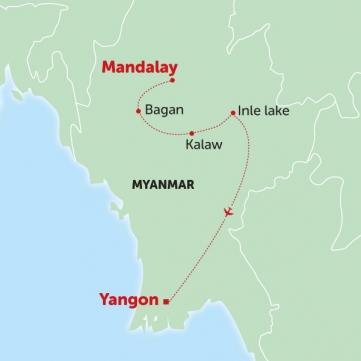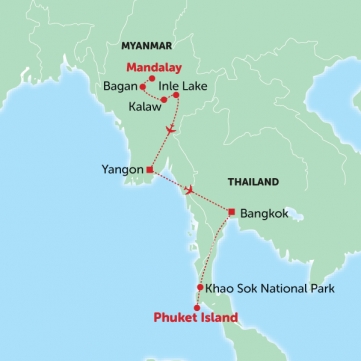Book NOW for $1 £1 €1 • Flexible Payments • No Change Fees • Private Departures Available
- Home >>
- Destinations >>
- Asia >>
- Burma
Burma Tours
Commonly known as Myanmar, Burma is still relatively undiscovered territory having only recently opened up to tourists and backpackers. It is a county packed with beautiful and breathtaking temples and mesmerising scenery.
Burma Travel Articles, Inspiration & Information
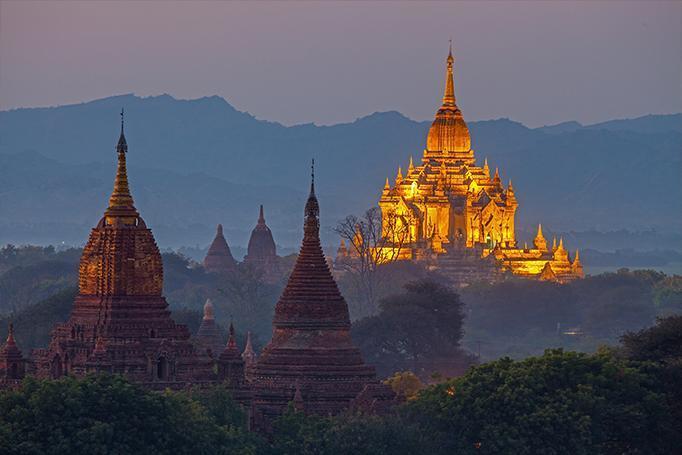
Exploring Burma
Burma, also known as Myanamar is begging to be explored. If you do not know what to expect about this fascinating country, then read this feauture to ease any worries that you may have. Amanda loved her adventure, and how it differed from many other countries in South East Asia. Read more
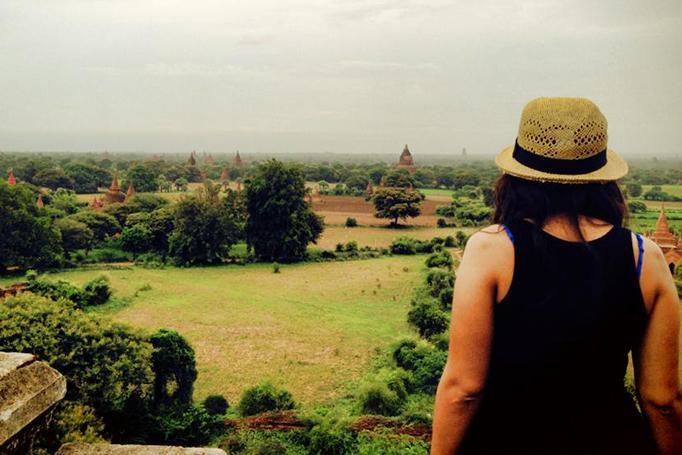
Tips for travelling to Burma
My adventure to Burma was amazing. I would like to say that there is nothing that I would change, but there are a few things that I would do differently if I could. On reflection, I would think more about how to pack properly for Burma. Read more
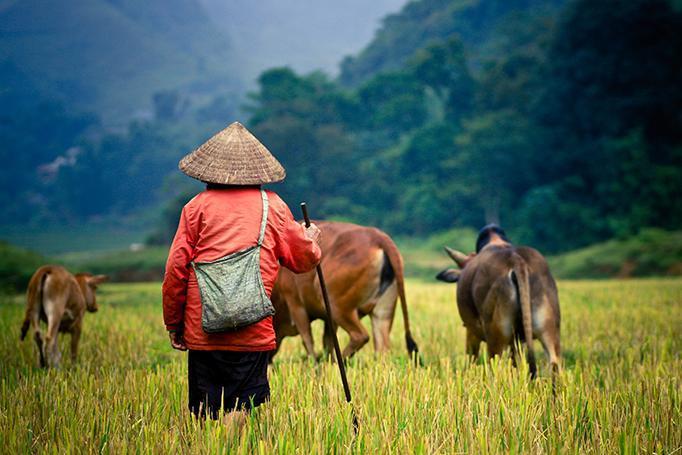
It’s A Jungle Out There
Formerly called Burma, Myanmar has only recently started opening up to westerners. Discover why there has never been a better time to visit this very special emerging destination with this article from past Tucan Traveller. Read more
Independently Verified Travel Reviews From Past Clients
Burma Travel Guide
Burma/Myanmar Travel Guide
To arrive in Myanmar is to step back in time, where the pervasive influence of Western culture has yet to firmly take root and where men still wear the traditional longyi and elderly can still be seen chewing betel, staining their teeth and gums a deep red. It is the land of thousands of stupas from the plains of Bagan to the gilded heights of Shwedagon Paya. Closed off from the rest of the world for many years, Myanmar has a near-mystical appeal for travellers looking for a unspoilt corner of the globe. Its culture, food, landscape and history combine to make it one of the world's most attractive and alluring destinations. At the heart of this destination are its people, famed for their humorous, generous nature and ethnic diversity.
Money
Myanmar's currency is the Burmese kyat (symbol: K) which is made up of 100 pya. Bank notes come in 1, 5, 10, 20, 50, 100, 200, 500, 1000, 5000 and 10000 kyat denominations and coins come in 1, 5, 10, 50 and 100 kyat denominations.
ATMs that accept international cards such as Visa and Mastercard are only just starting to appear in major towns and tourist areas, but they should not be relied upon as your primary source of funds. It is better to arrive with the money you will need for the duration of your trip in US dollars which can be exchanged when you arrive. It is important to bring only USD notes in pristine condition with serial numbers that do not pre-date 2006. Larger bills (US$50 and US$100) are exchanged at a slighter better rate than smaller notes and money can be exchanged at the airport or banks. Travellers cheques are not recommended.
Although the cost of travelling in Myanmar is increasing with its popularity as a destination, travel in Myanmar is still relatively inexpensive. Street food or a meal in a local restaurant starts from just a couple of dollars, up to $20-30 at a top restaurant with wine. Short taxi or tuk-tuk rides within cities are usually $1-2. A beer will usually set you back around $2.
Tipping is not customary in Myanmar but small donations may be expected when visiting temples and monasteries.
Major Cities and Towns in Burma/Myanmar
Myanmar's two major cities Yangon and Mandalay are where most travellers arrive by air. There is also an airport at the nation's capital city Nay Pyi Taw but it is not used by many airlines. Yangon is a former capital, has a mixture of colonial-era buildings and elegant Buddhist stupas and offers a good introduction to the country. Mandalay is the hub for upper Burma and a relatively new city which is considered the 'cultural capital'. Southeast of Mandalay is Bagan with its thousands of stupa ruins and southwest of Mandalay is Kalaw which is a popular start point for local trekking, including a 2-4 day walk to Inle Lake, famous for its vibrant lakeside communities. North of Mandalay Hsipaw is start point for walks to ethnic minority villages and nearby Pyin Oo Lwin is a British colonial curiosity with neatly clipped gardens and elegant buildings. West of Yangon there are several beaches, the most well known being Ngapali.
Electricity
In Myanmar power runs on 230 volts and the most common plug sockets are those that take two round prongs (such as in Europe) or UK-type sockets with three larger prongs. Some hotels will also have multi-type power socket which accept both round or flat prongs. These vary however, so to be sure, it is best to carry an international adapter with you to cover your bases.
Etiquette and Culture
Myanmar's people are made up eight official ethnic races and 135 recognised distinct ethnic groups, making it a melting pot of diversity. Bamar, Shan, Mon, Kayin, Kayah, Chin, Kahin and Rakhaing are the eight major ethnicities, each with its own unique costumes and traditions. The Bamar make up 69% of the population.
The national language is Burmese, and although there are many languages spoken throughout the country Burmese is understood by the whole country. You can greet someone by saying 'mingala-ba' which literally translated means 'auspiciousness by upon you'.
As Myanmar is a Buddhist country, it is important to observe their religious customs which include. removing your shoes before entering a temple, Buddhist site or home. You should never touch anyone's head, even children, nor point your feet towards another person or towards a religious image or statue (when seated). Posing with Buddhist images is also considered bad form, in particular as it involves turning your back towards the image.
Geography
Myanmar is a long country that borders with Bangladesh, India and China in the north, and Laos and Thailand to the west and south. The southern tip of the country extends down towards the Malay Peninsula with a hot, humid climate, similar to Malaysia. The area south-west of Yangon is characterised by vast river delta and known for its rice cultivation. Central Myanmar is dominated by broad, flat lowlands, named the country's 'dry zone' as the mountains and hills that surround it protect it from receiving much rainfall. The Kachin Hills in the north-west form the foothills of the Himalayas and include Myanmar's highest mountain, Hkakabo Razi, at 19,295 feet. Three major river systems travel down the country, fed by monsoon rains and snow melt from Nepal and India, the Irrawaddy River, the Chindwin River and the Thanlwin River.
History
The earliest people in recorded history were the Pyu and the Mon. The Pyu arrived from either the Tibeto-Burman plateau and/or India in the 1st century BC and established city-states in central Myanmar. The Mon people originated from eastern India or Southeast Asia established themselves in southern Myanmar. At its height, the Mon kingdom extended across Thailand and into Cambodia and they brought Buddhism to the region. The Rakhaing people were another group in the area, settling along the Bay of Bengal with their Buddhist kingdom based in Mrauk U.
By the 8th or 9th century the Bamar (also known as Burmans) arrived, supplanting the vanquished Pyu people and enigmatic ruler King Anawrahta established the first Burmese kingdom in 1044 with its capital at Bagan, adopting Theravada Buddhism as the state religion. His success was not continued by subsequent rulers and in 1287 the kingdom was invaded by Mongol leader Kublai Khan when the current king made the diplomatic error of murdering his envoys. What followed was a period of disunity where Shan tribes took control of parts of the low country and the Mon once again controlled the south.
Two hundred years later, the second Burmese Empire was established and the region was once again under Bamar rule. In 1550 Bayinnaung ascended the throne and reunified Burma, before invading the neighbouring Siamese kingdom of Ayutthaya. After his death, the kingdom began to decline and the capital was moved inland to Inwa in 1636 which was taken by rebelling Mon forces in 1752.
The third Burmese Empire was launched by King Alaungpaya, who contested the Mon's control of Inwa and established the Konbaung Dynasty (1752-1885), the last dynasty to rule Burma. The Konbaung kings expanded their kingdom, and much of modern Myanmar's borders can be traced to the activity of this period. Burmese troops crossed into British-controlled Assam (in India) in the early 19th century pitting the kingdom against a foe that would eventually lead to its downfall.
In a series of three wars between 1824 and 1885 the British took control of Burma, after which point it was administered as part of 'British India' and received an influx of Indian and Chinese immigrants marginalising the Burmese people. By the early 20th century, growing nationalist sentiment lead to strikes and protests against elitist colonial rule, calling for self-government and an end to colonial power in the region. In 1937, Burma's administration was separated from India and a new legislative council was formed with Burmese ministers.
National hero, Aung San and his group called the 'Thirty Comrades' gained military support and training from Japan, founding the Burmese National Army (BNA) when they returned in 1941 with Japanese forces to liberate Burma. By mid-1942 they had driven the British out of most of Burma, but found the Japanese not a great improvement, switching to support the Allies in March 1945. This gave them a better position from which to negotiate after World War II and in January 1947 Aung San met with British Prime Minister Clement Attlee agreeing to Burmese self-rule within a year. In the elections that followed Aung San's party won an overwhelming majority of the vote, however in July 1947 he and six of his aides were gunned down. His daughter and current national hero Aung San Suu Kyi was two years old at the time. On January 4 1948 Burma became independent and left the British Commonwealth, with Aung Sun's protégé U Nu taking the reins.
The country descended into chaos with ethnic minority groups, rebels and communist factions fighting for control until order was gradually restored in the 1950s. U Nu remained in power until 1958 when he voluntarily ceded leadership to a temporary military government. While initially this government made good progress, when U Nu was voted back into power General Ne Win ordered a military coup imprisoning the U Nu and many of his ministers and abolishing the civil government. What followed was a period of harsh socialism; private property was seized, freedom of speech and the press was curtailed, unemployment rose and living standards fell.
General Ne Win retired as president in 1981 but remained as chair of the ruling political party until protests 1988 called for his dismissal. The same year, a second military coup was staged forming the State Law & Order Restoration Council (Slorc) which promised to hold multi-party elections. Despite the government's attempts to appease the people, the election was won by the National League for Democracy (NLD) led by Aung San Suu Kyi and several former generals. Slorc then barred the winning party from taking power, arresting its leaders.
In 2007 Buddhist monks demonstrated in what was named the 'Saffron Revolution' protesting against escalating price rises. The protests were brutally suppressed by the government. The following year, the country was ravaged by Cyclone Nargis, the second deadliest cyclone in recorded history. Despite the damage, the military junta still held the previously planned referendum on a new constitution, claiming 92% had voted in favour.
In 2010 Aung San Suu Kyi was released from house arrest and in 2012 her party won by a landslide in by-elections. Reform in Myanmar continues with the release of political prisoners, greater freedom of the press and acceptance of foreign aid. The government is still criticised for human rights abuses and treatment of ethnic minorities.
Best time to travel in Burma/Myanmar
Seasons
Myanmar has two seasons, dry from October to May and wet from May to early-October. It is possible to visit the country year-round. The most popular time to visit is in December to February and this is when the tourist sites will be at their busiest and hotels most likely to be full. There are two shoulder seasons either side of this in October-November and March-April when the weather is still fair and there are likely to be fewer travellers. Low season is from May to September when the southwest monsoon arrives. Monsoon rains generally fall in the afternoon, leaving the morning and evening dry for site-seeing. Heavy rain may also affect transport and roads. The central part of the country including Mandalay is protected by mountains, creating a 'dry zone' which receives substantially less rain than the rest of the country during the monsoon.
When to travel
Along with seasonal variations there are other advantages to travelling at certain times of year. The largest festival of the year is Thingyan in April, also known as the water festival which marks the beginning of the Myanmar New Year. During this multi-day celebration, cold buckets of water are thrown over anyone in range. Celebrations also include dancing, drinking, singing and theatre.
Thadingyut festival falls in October or November every year marking the end of Buddhist Lent. This festival of lights is a countrywide event, but is most spectacular in Yangon and around Inle Lake, where food stalls and street performers mark celebrations and pagodas and the windows of peoples' homes are adorned with lanterns and candles.
Guide to food in Burma/Myanmar
Rice is at the heart of any Burmese meal and is served as an accompaniment to many traditional dishes. Like many south-east Asian cuisines, Burmese food seeks to balance different flavours, sour, salty, spicy and bitter. The cuisine has a blend of Indian, Chinese, Burmese and Mon influences and includes curries, soups, salads and noodle dishes.
One Burmese speciality is ăthouq, which is salad made of raw vegetables or fruits tossed in a dressing of lime juice, chilli, onions, chickpea flour and peanuts. The salads can have any number of ingredients, including rice or noodles.
Laphet is fermented tea leaves pickled with salt, garlic, dried shrimp and peanuts and is commonly eaten to finish a meal particularly in mountainous areas of the country.
Noodles are a common breakfast food or as small meals during the day. A common noodle dish is mohinga – widely considered the national dish – which is rice noodles in fish and shallot broth garnished with crispy lentils or deep-fried vegetables. Another popular noodle dish is onnokauswe with chicken pieces cooked in a coconut milk broth.
In addition to popular nation-wide dishes, there are regional variations. Shan cuisine bears many similarities to northern Thai cuisine and includes maung jeut which are a large rice cracker and Shan-style rice noodles with curry. Mon restaurants offer many variations of curry and tend to be hotter than other Burmese curries. There are also plenty of Chinese and Indian restaurants throughout Myanmar.
Desserts are not popular in Myanmar. Burmese sweets can be made from coconut, rice flour, tapioca and various types of fruit.
There are several local beers including the long-established Myanmar beer, and Mandalay beer.
Top Attractions and Highlights in Burma/Myanmar
1. Yangon
Home of the Shwedagon Paya with its brilliant golden spires, Myanmar's largest city is peppered with Buddhist shrines and architecture. It is also a wonderful place to sample Myanmar's cuisine and explore its vibrant open-air markets.
2. Bagan
The plains of Bagan are strewn with over 3000 Buddhist temples, rising from the earth like a stone forest of spires. The temples date back to the 11th and 13th centuries and the site is still actively visited by pilgrims and religious worshippers. Explore the ruins by bicycle or join the crowds at one of the popular sunset viewing spots.
3. Inle Lake
This vast expanse of water in the centre of the country is both a beautiful natural feature and a hub of human activity with tranquil net fishermen, floating gardens, shore-side markets and stilt-house villages. Where boats are the main form of public transport, you can explore the reaches of the lake by motorised canoe or traditional skiff.
4. Mt Kyaiktiyo (aka Golden Rock)
A gilded rock sitting a top the mountain, a visit to this religious site involves a tough uphill slog. The pilgrimage offers a glimpse into local spirituality as well as beautiful views of the surrounding area.
5. Pyin Oo Lwin
Offering respite from the heat of the Mandalay lowlands, this British colonial summer capital is littered with historic buildings and clipped botanical gardens. Take a tour by the local horse and cart taxi service, adding to the nostalgia and calm of this town.
6. Kalaw
This cool hill station is an ideal spot from which to base yourself for exploration of the surrounding hills. Take the popular 2-4 day trekking route from Kalaw to Inle Lake, or explore the surrounding area's Buddhist pagodas and tribal communities. Kalaw itself has leafy tree-lined streets and a diverse community including Nepali Gurkhas, Indian Hindus, Sikhs and Muslims.
7. Ngapali Beach
This idyllic spot has everything you'd expect from a tropical paradise, swaying palm trees, golden sand, turquoise water fading to deep blue and delicious seafood served alongside thatched seaside bungalows. Its the perfect way to begin or end a trip with some rest and relaxation.
8. Mrauk U
A mystical scene of monasteries, temples and city fortifications, the ruins of Mrauk U are Myanmar's second most famous archaeological site after Bagan. The buildings here are younger and smaller than its better known counterpart, but unlike Bagan, the area still has a thriving village atmosphere with people living around the old structures.
9. Mandalay
Tucked away within the chaos of Myanmar's second largest city are pockets of markets, artisans and monasteries as well as theatres offering performances of traditional performing arts. It is also home of the iconic U Bein bridge, the longest teak bridge in the world, and surrounding sites of interest including three former royal capitals which make interesting day trips from the city.
10 Interesting Facts about Burma/Myanmar
1. Myanmar has spectacular biodiversity. According to the Asean Centre of Biodiversity it has 1000 bird species, 400 reptile species and 300 species of mammal.
2. In March 2006 Myanmar's capital was officially moved from Yangon to the custom-built city of Nay Pyi Taw some 240 miles north of Yangon. Construction of the city began in 2004 on an isolated site and unlike much of the rest of the country it benefits from 24-hour electricity supply. The government was criticised by some for the untold expense of the endeavour.
3. Thanakha is a popular cosmetic in Myanmar, and takes the form of a light coloured paste that is applied to the face moisturising and protecting skin from the sun. It is made from the ground bark of certain trees that grow in central Myanmar.
4. Myanmar is one of only three countries in the world (the other two being Liberia and the United States) not to have adopted the metric system, still using traditional Burmese units of measurement in daily life.
5. Myanmar is the world's third largest producer of illicit opium, with an estimated production of 690 million metric tons in 2012. Almost all poppy cultivation within Myanmar occurs in the north-eastern Shan state.
6. Political activist and national hero Aung San Suu Kyi was awarded the Nobel Peace Prize in 1991. At the time of the awards, she was under house arrest in Myanmar by the military junta and was unable to accept her award, her two sons accepting it on her behalf. Over 20 years later, after she was released, she travelled to Norway to at last be able to deliver her acceptance speech.
7. Is it Myanmar or Burma? The UN adopted the name Myanmar, the United States of America's official name for the country is still Burma (as of 2014). The country's name was changed to Myanmar in 1989 by the ruling military junta on the grounds that 'Burma' suggested ethnic supremacy of the Burman majority. Some refuse to accept the new name on the grounds that a government that was not democratically elected cannot change the name of a nation and the name change was illegal. This is why both names are often used, including in many guide books and maps.
8. In the 2008 Beijing Olympics, some Taiwanese supporters used the Burmese flag which, at the time, was almost identical to the Taiwanese flag. The reason for this is China considers Taiwan part of its territory and it had compete under the name 'Chinese Taipei' and use a special Olympic flag, as flying its own flag in China was illegal.
9. Myanmar remains one of the poorest country in Asia. As of 2013, more than one quarter of the country's 60 million people were living in poverty.
10. Chinlon is an indigenous sport of the area, involving a small woven rattan ball which is kicked around a circle of players. When played formally, chinlon involves six players who must keep the ball in the air using a succession of 30 different techniques and six surfaces of the foot and leg.



